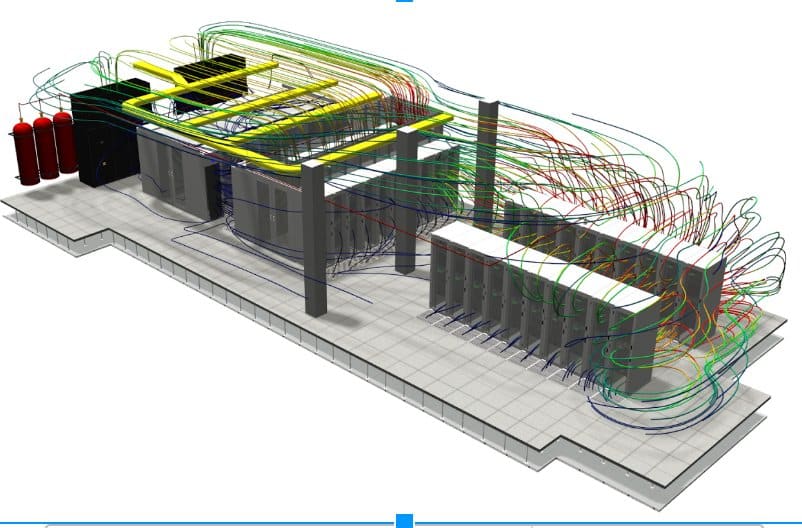Heating, Ventilation, and Air Conditioning (HVAC) systems are crucial for maintaining optimal indoor comfort in residential and commercial buildings. Designing these systems involves finding a balance between efficient airflow, low pressure drop, energy consumption, and cost-effectiveness. Traditionally, engineers and designers have relied on physical prototyping and testing to optimize HVAC system performance. However, this approach is time-consuming, expensive, and limited in exploring various design variations.
Ventilation simulation and computational fluid dynamics (CFD) provide a solution to these challenges. By leveraging CFD software like SimScale, engineers can digitally prototype and test HVAC system designs using their preferred CAD models. This cloud-native engineering simulation software offers access to high-performance computing (HPC) through a web browser, allowing engineers to explore the full design space of HVAC products and systems. This article discusses the benefits of ventilation simulation and CFD in HVAC design, focusing on optimizing air handling units, ventilation louvres, and diffusers.
Common Problems In HVAC Design
Two critical factors in HVAC design are minimizing pressure drop across the system and maintaining energy-efficient airflow. Pressure drop refers to the resistance encountered by air as it flows through components such as dampers, filters, and louvres. By optimizing the pressure-flow characteristics of these components, engineers can enhance overall system performance. Ventilation simulation using CFD enables engineers to address these design challenges effectively.
Optimizing Air Handling Units Using CFD

Air handling units (AHUs) are key components of HVAC systems responsible for circulating, purifying, conditioning, and renewing indoor air. CFD simulation allows engineers to design and verify AHU performance by analyzing airflow and pressure drop. Simulating airflow through individual components, such as control dampers, filters, and heating coils, helps engineers understand the installed performance of the system. It also enables them to evaluate the impact of different environmental operating conditions on airflow.
Pressure drop analysis is essential in optimizing AHUs. By calculating the pressure drop across each component and the entire system at various flow rates and temperatures, engineers can identify areas for improvement. Vibration and structural stress studies are also conducted to minimize vibration and structural issues caused by blowers and fans.
Enhancing Ventilation Louvres With CFD

Ventilation louvres play a crucial role in controlling airflow and pressure in HVAC systems. CFD simulation aids in optimizing the pressure-flow characteristics of louvres. It helps determine the nominal discharge coefficient, evaluate aerodynamics, and analyze flow separation, high-velocity zones, and pressure loss. Additionally, porous modeling can be used to calculate porosity factors and develop pressure loss curves for comparative analyses and sizing.
Case Study: Smartlouvre Technology Ltd.
Smartlouvre Technology Ltd. utilized CFD capabilities within SimScale to model and simulate their metal fabric product, MicroLouvreTM. This product is attached to external windows and serves as a natural ventilation and solar shading device. By evaluating the pressure-flow characteristics, they determined a discharge coefficient (Cd) of 0.39. This information can be integrated into building simulation and thermal modeling tools for architects and engineers to simulate airflow in buildings incorporating MicroLouvre.
Optimizing HVAC Units And Diffusers

The demand for improved air quality and ventilation in indoor spaces has grown, particularly due to the COVID-19 pandemic. SimScale enables engineers to design HVAC units and specialty diffuser grills, considering factors such as air mixing, exchange rates, and occupancy requirements. Parallel simulation studies can optimize the unit’s air path, reducing pressure drop and energy consumption.
Cloud-Native Ventilation Simulation
SimScale’s cloud-native engineering simulation software offers engineers and designers the ability to access high-speed parallel computing for faster iteration and design convergence. Parametric modeling capabilities empower engineers to explore a broader design space and refine their designs early in the development phase. This eliminates the need for costly physical prototypes and test rigs, resulting in accurate and efficient HVAC system design.
In Conclusion
Ventilation simulation and CFD provide HVAC engineers with powerful tools to optimize system performance. By leveraging these technologies, engineers can analyze airflow, pressure drop, and structural integrity, leading to energy-efficient and cost-effective HVAC designs. The use of cloud-native simulation software like SimScale enables engineers to iterate rapidly, reduce design iterations, and achieve optimal HVAC system performance without the need for extensive physical prototyping.






GIPHY App Key not set. Please check settings